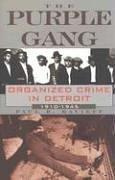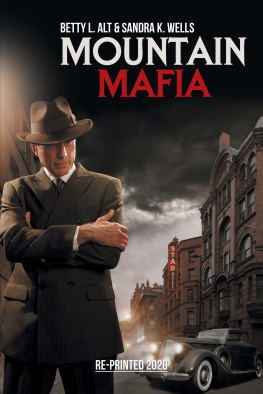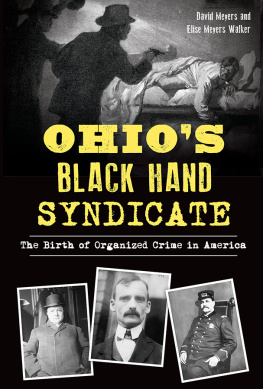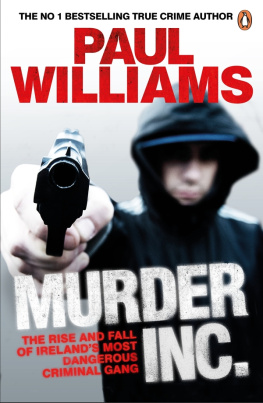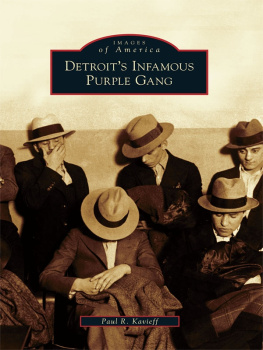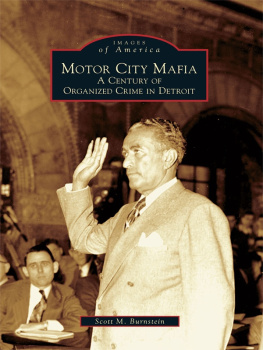Paul R. Kavieff - The Purple Gang: Organized Crime in Detroit 1910-1945
Here you can read online Paul R. Kavieff - The Purple Gang: Organized Crime in Detroit 1910-1945 full text of the book (entire story) in english for free. Download pdf and epub, get meaning, cover and reviews about this ebook. year: 2005, publisher: Barricade Books, genre: Non-fiction. Description of the work, (preface) as well as reviews are available. Best literature library LitArk.com created for fans of good reading and offers a wide selection of genres:
Romance novel
Science fiction
Adventure
Detective
Science
History
Home and family
Prose
Art
Politics
Computer
Non-fiction
Religion
Business
Children
Humor
Choose a favorite category and find really read worthwhile books. Enjoy immersion in the world of imagination, feel the emotions of the characters or learn something new for yourself, make an fascinating discovery.
- Book:The Purple Gang: Organized Crime in Detroit 1910-1945
- Author:
- Publisher:Barricade Books
- Genre:
- Year:2005
- Rating:4 / 5
- Favourites:Add to favourites
- Your mark:
- 80
- 1
- 2
- 3
- 4
- 5
The Purple Gang: Organized Crime in Detroit 1910-1945: summary, description and annotation
We offer to read an annotation, description, summary or preface (depends on what the author of the book "The Purple Gang: Organized Crime in Detroit 1910-1945" wrote himself). If you haven't found the necessary information about the book — write in the comments, we will try to find it.
The Purple Gang: Organized Crime in Detroit 1910-1945 — read online for free the complete book (whole text) full work
Below is the text of the book, divided by pages. System saving the place of the last page read, allows you to conveniently read the book "The Purple Gang: Organized Crime in Detroit 1910-1945" online for free, without having to search again every time where you left off. Put a bookmark, and you can go to the page where you finished reading at any time.
Font size:
Interval:
Bookmark:
THEPURPLE GANG
organizedcrime in detroit
1910-1945
PaulR. Kavieff
BARRICADEBOOKS NEWYORK
150 FifthAvenue
Suite 700
New York,NY 10011
Copyright 2000 by Paul R. Kavieff All Rights Reserved.
No part ofthis book may be reproduced, stored in a retrieval system, ortransmitted in any form, by any means, including mechanical,electronic, photocopying, recording, or otherwise, without the priorwritten permission of the publisher, except by a reviewer who wishesto quote brief passages in connection with a review written forinclusion in a magazine, newspaper, or broadcast.
Library ofCongress Cataloging-in-Publication Data
Kavieff,Paul R.
The PurpleGang : organized crime in Detroit, 1910-1945/Paul R. Kavieff p. cm.
1.Gangs--Michigan--Detroit--History?-20m century. 2. Organizedcrime--Michigan--Detroit--History--20th century. 3. Purple Gang(Organized Crime Group : Detroit, Mich.) I. Purple Gang (OrganizedCrime Group : Detroit, Mich.) II. Title
HV6439.U7D475 2000 364.1'06'6077434--dc21
00-028903
SecondPrinting
Printedin the United States of America.
Contents
Acknowledgments
Preface
chapter1 Origins of the Purple Gang 1902-1919
chapter2 The Birth of the Oakland Sugar House Gang 1922-1926
chapter3 The Murder of Johnny Reid 1920-1926
chapter4 The Milaflores Apartment Massacre 1927
chapter5 The Murder of Vivian Welch 1928
chapter6 The Cleaners and Dyers War 1925-1928
chapter7 The St. Valentine's Day Massacre 1928-1930
chapter8 Bloody July1930
chapter9 Collingwood Manor MassacreThe Era of Decline1931
chapter10 The Self-Destruction1932-1935
chapter11The Brothers Fleisher 1934-1940
chapter12 Harry Millman: Last of the Purple Gang Cowboys 1931-1937
chapter13 The Murder of Warren Hooper 1945
chapter14 The Prison Years 1930-1965
Bibliography
Dedication
Iwould like to dedicate this book to my wife, Deborah A. Carson.
Acknowledgments
Thisbook would not have become a reality without the help and support ofmany people. I would like to thank Pat Zacharias and her staff at theDetroit News Reference Library for their valuable help over a periodof years; Thomas Featherstone of the Reuther Library, Wayne StateUniversity; Dave Poremba of the Burton Historical Collection, DetroitPublic Library; Sharon Brown of the Michigan State Police, CentralRecords Division; John Currie and Mary Zumeth of the Michigan StateArchives; the late Max Silk, who spent many hours with me sharing hismemories about the Prohibition era; Penelope A. Morris, owner of theP. A. Morris Co., for her help in editing and creating a hard copy ofthe work; Stephen Rosman; Heidi Christein; Pat Henahan; Richard J.Smith and his family; my colleagues and friends in the EngineeringUnit at Wayne State University; Dave Rosen; Harry "Harry theHat" Stone, a former Purple; Richard Bak; Patterson Smith; MikeWebb; Bill Helmer; and Loren D. Estleman. A special thanks to myeditor, Allan J. Wilson, for his valuable advice, and to thepublishers, Carole and Lyle Stuart, for making the Purple Gang storya reality.
Preface
ThePurple Gang was one of the most ruthless organized crime groups inU.S. History. From the chaotic streets of Detroit's lower east side,this group of predominately Jewish gangsters would muscle their wayinto the underworld by 1927, where they would remain through a fiveyear reign of terror. It left an estimated five hundred unsolvedmurders in its wake.
Publicfear embraced the citizens of early 20th century Detroit. Nobodywould testify against anyone suspected of being a Purple. Jurors inPurple Gang cases were bribed or threatened with death. Courts couldnot get a conviction of significance on a Purple until the earlythirties.
Thesuccess of the Purples had more to do with their high profile methodsand their strong arm tactics than with cunning. The gang flourishedduring Prohibition before the advent of scientific detectiontechniques like DNA testing. Bribery of Federal and local officialscontrolled the law, but in the end it was neither science nor the lawthat brought the gang down. It was their own greed and jealousy.
Herefor the first time is the story of the rise and fall of one ofAmerica's most notorious organized crime
groups.The Purple Gang was an eerie, spectacular part of an American era inwhich a post-World War I nation groped for its place in the modernworld order.
PaulR. Kavieff
RoyalOak, Michigan
February2, 2000
Chapter 1
Originsof the Purple Gang
"Theseboys are not like other boys of their age, they're tainted, offcolor."
"Yes,"replied the other shopkeeper. "The whole bunch of them arePurple, they're a Purple Gang."
HastingsStreet Shopkeepers circa 1918
Itall began in 1902 when a youngshoemaker named Harry Bernstein arrived in Detroit with his wife andchildren. The family established a small shoe repair shop located at401 Gratiot Avenue on the city's Lower East Side, not far fromDetroit's Jewish ghetto district. Making a living was a challengingtask for immigrants in those years. Bernstein, a Polish Jew, movedwith his family from Russia to the tenement section of Manhattan'sLower East Side. The first years in America were the most difficult,one had to learn a new language and adapt to a new culture.
Bernstein'seldest son Abe was the second of seven children. Young Abe spent hischildhood years growing up fast on the streets of New York City.
Afterscratching out a living in New York, Harry finally saved enough moneyto open a small shop of his own. The competition in New York City wastough. The country-like atmosphere of turn of the century Detroit wasmore welcoming, and so became the site of Bernstein's first shop.
Whenthe Bernstein family moved to Detroit the city was on the verge of anenormous population and industrial explosion which brought ondisease, overcrowded housing, poverty and an increase in crime.
Theelder Bernstein and his wife spent long hours in their small shopstruggling to support their growing family. During their first yearsin Detroit they lived in a small apartment above their shop. A secondson, Joseph, came after Abe, followed by Jennie, Raymond, Ida andIsadore.
AlthoughBernstein's eldest son Abe was a bright child with obvious potential,he showed little interest in school. He was a streetwise 9-year-oldby the time the family moved to Detroit. He dropped out to hawknewspapers in the Detroit business district, and then worked for FordMotor Company to help support the family.
Bythe time Abe married he'd started working in the thriving Detroitarea gambling houses. Gambling, technically illegal, had developedinto a racket nourished by payoffs to politicians and policeofficials.
Hebecame a skilled card dealer and stickman. He also met the mostimportant politicians, police officials, and underworld figures ofthe era.
Abe'syounger brothers Joe, Raymond, and Isadore (Izzy)fended for themselves on the streets. Theirs was a Jewish ghetto thatstretched from Jefferson Avenue to East Grand Boulevard. Its outerboundaries extended a little more than two blocks east and west ofHastings Street.
Manyfuture Purple gangsters came from this neighborhood. Their parentswere for the most part working class, non-Orthodox Jews. HastingsStreet, known as "Paradise Valley," was bustling withactivity during the teens and early twenties. It was a heavilyindustrial area where children played on soot-covered streets.
Hucksterspeddled their wares from pushcarts and replenished them at the nearbyEastern Market. Saloons and disorderly houses catered to the needs offactory workers at all hours of the day or night as shifts let out atthe manufacturing plants.
Thechildren of these immigrants saw their parents work long hours, yetearn only enough to provide bare necessities. They also saw men whoseemed to live the good life without working.
Next pageFont size:
Interval:
Bookmark:
Similar books «The Purple Gang: Organized Crime in Detroit 1910-1945»
Look at similar books to The Purple Gang: Organized Crime in Detroit 1910-1945. We have selected literature similar in name and meaning in the hope of providing readers with more options to find new, interesting, not yet read works.
Discussion, reviews of the book The Purple Gang: Organized Crime in Detroit 1910-1945 and just readers' own opinions. Leave your comments, write what you think about the work, its meaning or the main characters. Specify what exactly you liked and what you didn't like, and why you think so.

